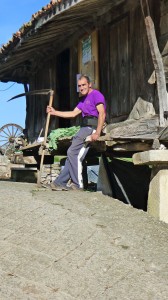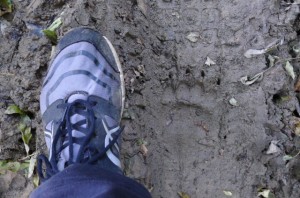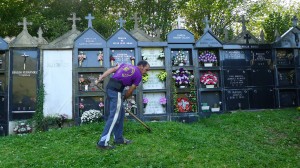The world of Pepe
We meet Pepe 3 times: First during the mushroom walk, the second time on our way up to the Camino Real de la Mesa where he shows us his beautiful house, and a third when we return to Samartín de Ondes to meet him with more leisure, for Frank to give him a massage and to spend a few days with him and in his village.
Following an industrial accident that left his back severely damaged, Pepe has spent 12 years working with wood to calm his mind. The result is a beautifully decorated house where every piece of wood is carved with floral and celtic patterns. But it is also clear that this beauty is wrought from pain; there is a slight melancholy in the house, an atmosphere of ‘waiting’ for something, for someone…
Every stone, every piece of wood tells a story, and Pepe knows many of them first hand. He tells us how he grew up in this house, with his 8 older siblings, his father, mother and grandparents, all sharing two bedrooms, how after the war they started with nothing and they worked very hard.
He went to school in Belmonte, 5km down the hill. From his stories, you get the impression that this was already too far away from home: it was cold there and the rumble of stone boulders and tree trunks in the river in winter frightened him. He felt cooped up in the school room, longing to be out and about, climbing trees and catching the warm breeze of Samartín. It is significantly warmer up there than down in the valley, where the sun only reaches a few hours per day….
We visit his workshop to see how he researched into traditional ways of working, with pegs in the wall that hold the wood in a particular position, and traditional carving tools and techniques, eg. how to cut fine slices of wood from hazelnut poles to weave baskets. Traditionally the work bench itself would also have been a big beam protruding from a wall.
We visit his garden and learn about traditional uses of some of the local herbs, eg. how people used lemon balm to clean out the big cider barrels, and how the yellow sap of a local weed that grows everywhere is used to treat any wounds in the skin, how to plait corn cobs so as to hang them to dry (as can be seen hanging under the eaves of many horreos). We pick from his vegetables and delicious fruits to make a shared dinner. He appreciates our cooking for him (and his house is happy, being lived in and used), although he thinks that we cook too fast – the vegetables should be cooked slowly for several hours, not fast and hot. He approves of the combination of ‘smashed’ potatoes and mint, even though it is new to him – se puede comer!
He shows us how the people of Samartín cut their chestnuts to roast them on the fire – not with a cross in the top but chopping off two little bits of the skin at the side. When the chestnut is roasted, you just have to squeeze it and it pops out!
It is a joy to watch Pepe around animals, especially horses. They seem to calm down instantly when he’s around and to just do what he wants them to do, without him having to say or do anything. It’s almost like magic!
Pepe takes us on various walks and without seeming to teach us, he is a constant source of information: how to track footprints in the woods (we find some bear prints!), what the difference between wild and cultivated species of hazelnut, apple, chestnut etc is and what they are used for, where to find mushrooms and which are edible etc etc.
He has an open eye for everything, even an oddly shaped root that can be turned into an interesting piece of decoration. He is a dab hand at scything, as we can see when we visit the graveyard with him and his sister on the day before All Souls. In a few strokes he has mown the grass down…
He also knows about the local history. He explains the difference between an horreo and a panadera, the two types of food storage buildings typical to the area. They are usually made of oak wood, and some of them are over 300 years old. Apparently, if you drive against an horreo, it moves but doesn’t collapse, it’s flexible. If you tried to hit the wood with an axe (who would want to do that???), the axe will jump back at you, it’s as hard as iron.
He takes us to a disused water mill and shows us how it worked to create electricity until about 50 years ago, when one of the people in the village sold the rights to a larger company who now run large hydroelectric projects in the area.
He shows us the well where people had to come to get water, before a fountain and wash house was built in the village.
He tells us how the paths that connect one village to the other are flanked with hazelnuts so they create a closing cover, which prevents anything else from growing on the path, thus maintaining itself.
He shows us the old path up to the village cemetery, which was so steep and narrow that people had to carry their dead on their backs.
He has stories of his childhood, when he was a naughty boy, roving through the woods with his brothers, finding birds nests and swapping their eggs (!), until they are suddenly caught out by the dark, and how he had to run past a particular part in the woods where he got frightened of the dark shapes of the trees. Most of his family have gone away to live in bigger cities but a couple of his siblings still live in Samartín, and without fail, they eat together every day at 1pm.
One beautiful sunset-evening, Pepe lovingly points out the dominant rock above the village and tell us how he never really left Samartín, that he has no interest in seeing the world – with so much to see right on his doorstep, why travel further? Every day, stepping out of his door into nature is for him like seeing it for the first time. There is so much to learn from nature right here, to listen and learn from the elders and to experiment with plants and wood.
There is a contentment to him, and yet a longing to share this: a loneliness, but also a happiness in his solitude.
He is a deep thinker, a humble and openhearted Mensch, and he is very connected to the place where he was born and has lived all his life. There is no small-talk with Pepe. Our meeting with Pepe of Samartín de Ondes was very special and went deep into our hearts.
Thank you, Pepe, in three days of accompanying you around the village, we learnt so much from your stories. We hope we understood your stories properly and apologise for any misrepresentations: our Spanish has improved, but if we got something wrong, it is not down to your lack of explanation, but our limited vocabulary.
*To find Pepe – go to Samartín de Ondes and ask for him! He’s not on the internet. He said he’d be happy to meet and host any of our friends, as long as they are like us 
The house is ready and happy to receive guests: 3 double bedrooms with ensuite bathrooms, and downstairs a large kitchen and dining room.
*To see more photos for this chapter, go to https://www.flickr.com/photos/126714897@N05/sets/72157649120512722/
Posted in Uncategorizedwith comments disabled.


